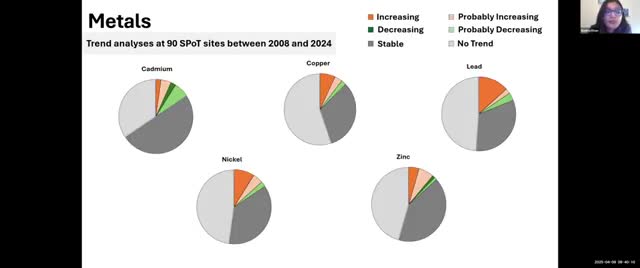SPOT program: PFAS detected widely at urban tier‑2 sites, but trends need more years of data
April 26, 2025 | California Water Quality Monitoring Council, Boards and Commissions, Executive, California
This article was created by AI summarizing key points discussed. AI makes mistakes, so for full details and context, please refer to the video of the full meeting. Please report any errors so we can fix them. Report an error »

UC Davis researchers updating the SPOT monitoring program reported that PFAS compounds were frequently detected at the program’s urban (tier 2) sites in the 2023–2024 paired dataset, and that some sites show complex PFAS fingerprints warranting follow‑up.
"PFOS ... was detected at 36 out of 40 sites," Bushra Khan said when summarizing the 2023–2024 PFAS sediment results measured using EPA Method 1633‑type analyses. She added that PFOA and longer‑chain carboxylates (C10–C14) were also common at urban sites.
Why it matters: PFAS are persistent and bioaccumulative. SPOT staff emphasized that two years of high‑quality data are not yet sufficient to run robust Mann‑Kendall trend analyses for statewide conclusions; program staff said they need two additional years of comparable data before reporting trends.
Details and site results: Khan showed percent‑detection plots and ‘‘sum PFAS’’ comparisons across the 40 tier‑2 urban sites. Three sites — including Bouquet Canyon (Region 4) — had the highest summed PFAS concentrations in 2024, and Bouquet Canyon saw higher total PFAS in 2024 than in 2023. Khan noted these sites also had complex PFAS mixtures and were among sites identified as toxic based on other endpoints; she cautioned that the sites’ overall toxicity is driven by multiple contaminant classes and that PFAS alone were not reported at toxic levels.
Program response and next steps: Presenters recommended continuing PFAS monitoring at the 40 tier‑2 sites to build the time series, and suggested adding a limited number of agricultural and other nonurban sites to the sampling frame to test whether PFAS at smaller numbers of agricultural locations are present and changing. Committee members suggested leveraging other programs and funding (for example, drinking‑water testing and local discretionary funds) to expand PFAS coverage and emphasized coordination on analytical methods.
Collaboration offers: Division of Water Quality staff said they are running PFAS monitoring in drinking wells and water samples with non‑targeted PFAS methods and suggested coordination; the UC Davis team and regional boards discussed seeking external funds to add targeted PFAS monitoring in agricultural areas.
Ending: SPOT will continue PFAS sampling at tier‑2 urban sites; UC Davis staff recommended collecting at least two more years of consistent data before conducting statewide trend tests and urged coordination with drinking‑water and regional monitoring programs to better understand sources and transport.
"PFOS ... was detected at 36 out of 40 sites," Bushra Khan said when summarizing the 2023–2024 PFAS sediment results measured using EPA Method 1633‑type analyses. She added that PFOA and longer‑chain carboxylates (C10–C14) were also common at urban sites.
Why it matters: PFAS are persistent and bioaccumulative. SPOT staff emphasized that two years of high‑quality data are not yet sufficient to run robust Mann‑Kendall trend analyses for statewide conclusions; program staff said they need two additional years of comparable data before reporting trends.
Details and site results: Khan showed percent‑detection plots and ‘‘sum PFAS’’ comparisons across the 40 tier‑2 urban sites. Three sites — including Bouquet Canyon (Region 4) — had the highest summed PFAS concentrations in 2024, and Bouquet Canyon saw higher total PFAS in 2024 than in 2023. Khan noted these sites also had complex PFAS mixtures and were among sites identified as toxic based on other endpoints; she cautioned that the sites’ overall toxicity is driven by multiple contaminant classes and that PFAS alone were not reported at toxic levels.
Program response and next steps: Presenters recommended continuing PFAS monitoring at the 40 tier‑2 sites to build the time series, and suggested adding a limited number of agricultural and other nonurban sites to the sampling frame to test whether PFAS at smaller numbers of agricultural locations are present and changing. Committee members suggested leveraging other programs and funding (for example, drinking‑water testing and local discretionary funds) to expand PFAS coverage and emphasized coordination on analytical methods.
Collaboration offers: Division of Water Quality staff said they are running PFAS monitoring in drinking wells and water samples with non‑targeted PFAS methods and suggested coordination; the UC Davis team and regional boards discussed seeking external funds to add targeted PFAS monitoring in agricultural areas.
Ending: SPOT will continue PFAS sampling at tier‑2 urban sites; UC Davis staff recommended collecting at least two more years of consistent data before conducting statewide trend tests and urged coordination with drinking‑water and regional monitoring programs to better understand sources and transport.
View full meeting
This article is based on a recent meeting—watch the full video and explore the complete transcript for deeper insights into the discussion.
View full meeting
